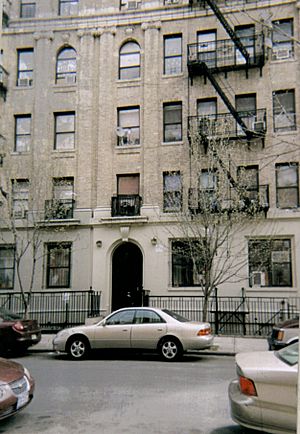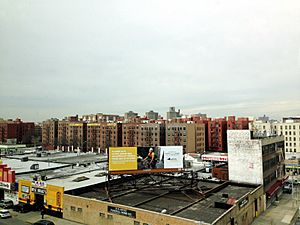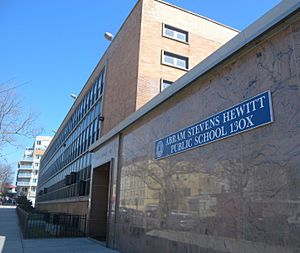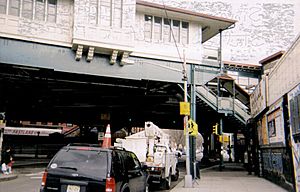Longwood, Bronx facts for kids
Quick facts for kids
Longwood
|
|
|---|---|
|
Neighborhood of the Bronx
|
|
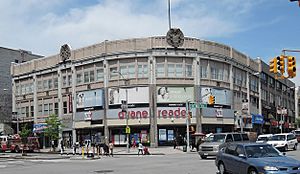
Southern Boulevard in Longwood
|
|
| Country | |
| State | |
| City | |
| Borough | |
| Community District | Bronx 2 |
| Area | |
| • Total | 1.27 km2 (0.489 sq mi) |
| Population
(2010)
|
|
| • Total | 26,196 |
| • Density | 20,684/km2 (53,570/sq mi) |
| Economics | |
| • Median income | $26,300 |
| Ethnicity | |
| • Hispanic and Latino Americans | 74.6% |
| • African-American | 22.4% |
| • White | 1.5% |
| • Asian | 0.5% |
| • Others | 1.1% |
| ZIP Codes |
10455, 10459
|
| Area code | 718, 347, 929, and 917 |
Longwood is a lively neighborhood in the southwest Bronx, a part of New York City. Its borders are East 167th Street to the north, the Bronx River and the Bruckner Expressway to the east, East 149th Street to the south, and Saint Anns Avenue to the west. Southern Boulevard is the main road that runs through Longwood.
The neighborhood is part of Bronx Community District 2. Its ZIP Codes are 10455 and 10459. The New York City Police Department's 41st Precinct keeps the area safe. The local subway, the 6 <6> trains line, runs along Southern Boulevard.
Contents
Longwood's Past: A Story of Change
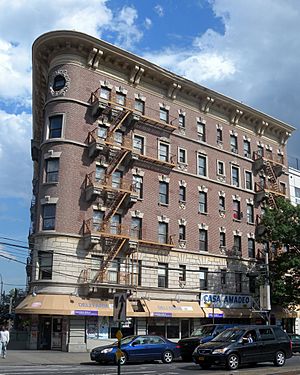
The Bronx began to grow quickly when streetcar lines were built. Later, subway lines from Manhattan helped the area develop even faster. Many 5- and 6-story apartment buildings were constructed, especially near subway stations. Longwood became one of the busiest neighborhoods in the Bronx. For much of the early 1900s, the Bronx was home to many middle-class families. These families were often from Europe and included people of Jewish descent.
Challenges and Recovery
Starting in the 1950s, the older parts of the Bronx, including Longwood, began to change. The Cross Bronx Expressway was built, which forced many people to move and split communities apart. New housing like Co-op City offered modern homes, and living in the suburbs became popular. As some people moved out, others with less money moved in.
By the late 1970s, many buildings in the South Bronx were badly damaged by fires. This was a difficult time for the community. The local police station, the 41st Precinct, was even called "Fort Apache" because of the high crime rates.
However, community groups like Banana Kelly CIA, Inc. and SEBCO worked hard to help. They brought attention to the problems and tried to protect the remaining buildings. Slowly, the area began to recover.
Rebuilding and Growth
In 1986, new funding started to come into the area. The NYCHA helped build and fix homes in Longwood. The city also supported local building projects. This led to more and more investment in the community.
By the mid-1990s, local and federal governments had invested over $550 million. This money helped build new homes and expand businesses. The South Bronx headquarters of the Police Athletic League of New York City was built, and the 41st Precinct police station moved to a new location. Investments were also made in Banana Kelly High School and many businesses.
Today, many new homes and shops have been built on empty lots. The neighborhood has changed from a difficult area to one with modern apartment buildings and renovated older homes. While some social challenges remain, Longwood is a symbol of how a community can improve and grow.
Who Lives in Longwood?
Longwood is mainly home to Latin Americans. It has one of the largest groups of Puerto Ricans in New York City. However, it also has a mix of other groups, including African Americans, White residents, and Asian residents. Like most places in New York City, many people rent their homes.
In 2010, the population of Longwood was 26,196 people. This was an increase from 23,082 people in 2000. The neighborhood covers about 0.489 square miles.
Based on the 2010 census:
- 74.6% of people were Hispanic or Latino.
- 22.4% were African American.
- 1.5% were White.
- 0.5% were Asian.
- The rest were Native American or from other groups.
Most people in Longwood and Hunts Point are young or middle-aged adults. About 28% are under 18, 29% are between 25 and 44, and 21% are between 45 and 64.
Longwood's Buildings and Features
Longwood is mostly made up of 5- and 6-story apartment buildings built before World War II. Since the 1990s, many new apartment buildings and row houses have been constructed. Some of the older buildings that were damaged in the past have been torn down.
The total land area of Longwood is about 0.5 square miles. The land is somewhat hilly.
Southern Boulevard Business District
Southern Boulevard is a busy area with many different types of businesses. The Southern Boulevard Business Improvement District was created in 2008 to help this area. You can find supermarkets, pharmacies, barbershops, fast food, and other stores along this main road.
The Crossings Mall
The Crossings is a two-level mall that is 40,000 square feet in size. It is located where Hunts Point Avenue and Bruckner Boulevard meet.
Longwood Historic District
The Longwood Historic District is a special area with historic buildings. It is located south of Longwood Avenue on streets like Beck, Kelly, Dawson, and Hewitt Place. This district mostly has semi-detached row houses. Many of these houses were designed by the same architect, Warren C. Dickerson.
Public Housing in Longwood
There are four NYCHA housing developments in Longwood:
- West Farms Square Rehab: four renovated apartment buildings, 6 stories tall.
- East 165th Street-Bryant Avenue: five buildings, 3 stories tall.
- Longfellow Avenue Rehab: two 5-story renovated apartment buildings.
- Stebbins Avenue-Hewitt Place: two 3-story buildings.
Local News
Since 2006, an online news outlet called The Hunts Point Express has reported on Hunts Point and Longwood. It is written by students from Hunter College and also comes out in print. You can find it for free in community centers and stores in the neighborhood.
Fire Safety
Longwood has its own New York City Fire Department (FDNY) fire station. It is home to Engine Co. 73 and Ladder Co. 42, located at 655 Prospect Avenue.
Health in the Community
The air in Longwood and Hunts Point has more tiny particles of pollution than the city average. About 15% of residents are smokers. Also, 42% of residents are obese, 20% have diabetes, and 38% have high blood pressure. These numbers are higher than the average for New York City.
Only 82% of residents eat some fruits and vegetables every day, which is less than the city's average. For every supermarket in Longwood and Hunts Point, there are 20 small convenience stores called bodegas. The closest hospital is NYC Health + Hospitals/Lincoln in Melrose.
Mail and ZIP Codes
Longwood uses two different ZIP Codes. The area north of Longwood Avenue is 10459, and the area south of Longwood Avenue is 10455. While there isn't a post office directly in Longwood, the United States Postal Service has a station in Hunts Point at 800 Manida Street.
Education in Longwood
Longwood and Hunts Point generally have fewer college-educated residents compared to the rest of New York City. In 2018, about 16% of adults aged 25 and older had a college degree or higher. However, 41% had less than a high school education.
The number of elementary school students who miss many days of school is higher in Longwood and Hunts Point. About 35% of elementary students missed 20 or more days in a school year. Also, 58% of high school students in Longwood and Hunts Point graduate on time, which is lower than the city average.
Schools in Longwood
Public Schools:
- PS 62: Inocencio Casanova
- PS 75: School of Research and Discovery
- PS 130: Abram Stevens Hewitt
- PS 150: Charles James Fox
- PS 333: The Museum School
- PS 335: The Academy of the Arts
- MS 302: Luisa Dessus Cruz
- Bronx Regional High School
- South Bronx Classical Charter School
- Bronx Lighthouse Charter School/Bronx Lighthouse College Preparatory Academy
- Bronx Studio School for Writers and Artists
- Banana Kelly High School
- Girls Prep Bronx Elementary
- Longwood Preparatory Academy (formerly Banana Kelly High School)
- Success Academy Bronx Middle School (BXMS)
Parochial School:
- St. Athanasius School
Libraries for Learning
The New York Public Library has two branches near Longwood. The Woodstock branch, a two-story building, opened in 1914. It is located at 761 East 160th Street. The Hunts Point branch, also a two-story building, opened in 1929 at 877 Southern Boulevard. The Hunts Point library is a historic landmark and was the last Carnegie library built for the New York Public Library system.
Getting Around Longwood: Transportation
Longwood is served by several MTA Regional Bus Operations bus routes, making it easy to travel around the neighborhood and to other parts of the city:
- Bx4: to Westchester Square or Third Avenue–149th Street (via Westchester Avenue)
- Bx4A: to Westchester Square or Simpson Street (via Westchester Avenue and Metropolitan Oval)
- Bx5: to Co-op City and Bay Plaza Shopping Center (via Bruckner Boulevard and Story Avenue)
- Bx6 and Bx6 SBS: to Hunts Point or Riverside Drive, Manhattan (via 161st and 163rd Streets)
- Bx17: to Fordham Plaza or Port Morris (via Prospect and Crotona Avenues)
- Bx19: to New York Botanical Garden or Riverbank State Park (via 149th Street and Southern Boulevard)
- Bx27: to Clason Point (via Rosedale Avenue)
- Bx35: to Crotona Park East or George Washington Bridge Bus Terminal (via 167th Street)
- Bx46: to Prospect Avenue or Hunts Point (via Longwood Avenue and Tiffany Street)
The following New York City Subway stations also serve Longwood, connecting residents to the rest of New York City:
- Whitlock Avenue (6 train)
- Simpson Street (2 5 trains)
- Intervale Avenue (2 5 trains)
- Hunts Point Avenue (6 <6> trains)
- Prospect Avenue (2 5 trains)
- Longwood Avenue (6 train)
- East 149th Street (6 train)
- Jackson Avenue (2 5 trains)
Famous People from Longwood
- Colin Powell, a well-known American general and politician, lived on Kelly Street and Fox Street in Longwood. He also attended Morris High School.


